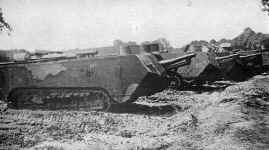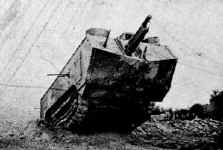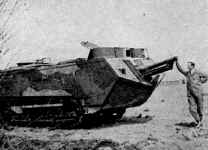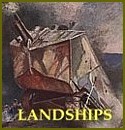JMGT:S 1/72 S:t Chamond
 The
Char Schneider C.A.1 was intended to be the standard French heavy tank
and an order was placed for 400 of them on 25 February1916. However,
Monsieur J. L. Breton, of the French Government department responsible
for war inventions, gave authority for the firm Forges et
Aciéries de la Marine et d'Homé-court, at Saint Chamond
near Lyon, to design another tank, larger and betterarmed than the
Schneider. Both departmental and industrial jealousy were involved
because this step was taken without full knowledge of the Army and neither
Joffre, the Commander-inChief, nor Estienne, the leading military
expert on the subject were consulted and there was no co-operation with
the Schneider firm.
The
Char Schneider C.A.1 was intended to be the standard French heavy tank
and an order was placed for 400 of them on 25 February1916. However,
Monsieur J. L. Breton, of the French Government department responsible
for war inventions, gave authority for the firm Forges et
Aciéries de la Marine et d'Homé-court, at Saint Chamond
near Lyon, to design another tank, larger and betterarmed than the
Schneider. Both departmental and industrial jealousy were involved
because this step was taken without full knowledge of the Army and neither
Joffre, the Commander-inChief, nor Estienne, the leading military
expert on the subject were consulted and there was no co-operation with
the Schneider firm.
 The
design of the Char SaintChamond, as it was known, was undertaken by
Colonel Rimailho of F.A.M.H who took as starting-point a lengthened Holt
Caterpillar chassis, which had been specially built up from parts of three
Holt tractors for comparison with the Schneider-built chassis in trials
at Vincennes on 21 February 1916.
The
design of the Char SaintChamond, as it was known, was undertaken by
Colonel Rimailho of F.A.M.H who took as starting-point a lengthened Holt
Caterpillar chassis, which had been specially built up from parts of three
Holt tractors for comparison with the Schneider-built chassis in trials
at Vincennes on 21 February 1916.
 In
addition to the handling faults, the Saint-Chamond was found to have further
defects when in action for the first time on 5May
1917. Facilities for crew exit in emergency were poor, vision arrangements
were inadequate and the recoil cylinder of the 75-mm. gun was found to
be vulnerable to enemy fire.
In
addition to the handling faults, the Saint-Chamond was found to have further
defects when in action for the first time on 5May
1917. Facilities for crew exit in emergency were poor, vision arrangements
were inadequate and the recoil cylinder of the 75-mm. gun was found to
be vulnerable to enemy fire.
 In
an effort to correct at least some of these faults, modifications were
introduced both in the course of production and retrospectively. After
the first 165 tanks (of the 400 ordered) were built, the 75mm. Saint-Chamond
T.R. gun was replaced by the standard 75mm Model 1897 field gun. The flat
roof with two circular cupolas of the early tanks was modified to a new
pattern higher at the front to give more headroom to the crew - there
was one square cupola at the left on most tanks. The tracks, which were
too narrow, were replaced with wider ones with a chevron tread pattern
to give more traction and to accommodate these the hull side plates over
the tracks had to be modified.
In
an effort to correct at least some of these faults, modifications were
introduced both in the course of production and retrospectively. After
the first 165 tanks (of the 400 ordered) were built, the 75mm. Saint-Chamond
T.R. gun was replaced by the standard 75mm Model 1897 field gun. The flat
roof with two circular cupolas of the early tanks was modified to a new
pattern higher at the front to give more headroom to the crew - there
was one square cupola at the left on most tanks. The tracks, which were
too narrow, were replaced with wider ones with a chevron tread pattern
to give more traction and to accommodate these the hull side plates over
the tracks had to be modified.
It
was recommended that additional 82 mm plates should be added to the side
plates (which were a basic 82 mm.) to give full protection against the
German `K' bullet, although this modification was not carried out in full.
Other features of the Char SaintChamond were the four Hotchkiss machine-guns
(one each side, one at the front, one at the back with 8488 rounds carried)
in addition to the main weapon (for which 106 rounds were supplied) mounted
in the front plate; its crew of nine men, and its weight (due mainly to
its heavy transmission system) of 24 tons.
 The
S:t Chamond was first used in action on May 5 1917, in support of an infantry
attack at Moule de Laffaux. The major flaw in the construction - the small
drive train and the big front overhang - at once revealed itself: of the
16 S:t Chamond tanks that participated in the assault, 15 got firmly stuck
when they attempted to cross the German trenches. In the next big tank
attack, both Schneider CA 1:s and S:t Chamonds participated, but the result
was again a flop: only the CA 1:s managed to pass the German trenches!
The
S:t Chamond was first used in action on May 5 1917, in support of an infantry
attack at Moule de Laffaux. The major flaw in the construction - the small
drive train and the big front overhang - at once revealed itself: of the
16 S:t Chamond tanks that participated in the assault, 15 got firmly stuck
when they attempted to cross the German trenches. In the next big tank
attack, both Schneider CA 1:s and S:t Chamonds participated, but the result
was again a flop: only the CA 1:s managed to pass the German trenches!
None
of the modifications introduced could make the Saint-Chamond into a good
tank and, after the French had given consideration to other designs to
replace it and the Schneider C.A., it was decided to accept the offer of
British heavy tanks for employment in the offensive planned for 1919.
If you want more info on the S:t Chamond, you simply MUST visit the Blindés Francais, an excellent French Site, with super material on this tank. And you should not miss these excellent walk around photos of the worlds only surviving S:t Chamond!
Well, I have to say it straight away: this is the best WW1 Braille Scale AFV kit you can find out on the market today! Cromwells Mk V* and Mk VIII are very close, but this one wins by a whisker. The kit comes packed in a sturdy cardboard box - illustrated by both a plan and a photo of the kit -, and is made in soft, light-yellow resin. The main parts are the hull, the bottom, the bow and the two track assemblies.
The track assemblies are made up of a number of parts and have both back, front and sides - no "half" parts here. There is also a number of smaller parts: the Hotchkiss MG:s - made in white metal and some of the very best I've seen -, a finely detailed 75mm cannon, an optional cupola etc. There is also some Photo-Etched parts supplied, including the makers star emblem!
The mouldings are really first rate, crisp and with no air bubbles; they are easily comparable to the very best, say Al-By. There is some flash on the track assemblies, but that's it. The dimensions, angles and details are correct. The kit includes a good set of plans and also - would you believe that? - some decals, alright so it's only numbers, but the gesture is truly appreciated. Note that JMGT produces two variants of the S:t Chamond: early and late.
This is the late variant, with the sloping roof, and retractable drivers cupola. Yes, I find it difficult to fault this kit. For all those not here in Europe, you can buy it from The Squadron Shop in the US. (But it is expensive to get it from them, and will cost anyone in Europe buying it hefty import duties.) For anyone in Europe the best bet is instead to contact Socrate themselves. Their address is
SOCRATE SARL
71, Grande Rue
95760 Valmondois
France
Tel : 33 1 34 69 60 00
Email : jm.gt@tele2.frAccording to Eric Gallaud (thanks for the info, Eric!) the price is some 30 Euros + P&P (5 Euro for France).

